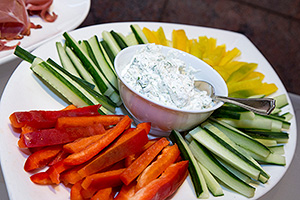Quick Tips: Making Healthy Snacks
Get started
A big part of healthy eating is eating more whole grains, fruits, vegetables, and low-fat milk products. Healthy snacks are a great way to make sure that you get plenty of these nutritious foods every day. Use these ideas to get started.

Make smart snack choices
- Find healthier substitutes for high-fat snacks. If your favorite high-fat snack is potato chips and dip, try baked tortilla chips with bean dip or hummus instead.
- Make snacks interesting. If the idea of a plain piece of fruit doesn’t appeal to you, try dipping fruit slices in low-fat yogurt sprinkled with cinnamon or nutmeg.
- Be prepared. Have snacks ready for when you get hungry. For example, keep healthy snacks with you at work or school, in your car, and at home. If you have a healthy snack easily available, it’s less likely that you’ll pick a candy bar or bag of chips instead.
Foods that make quick, healthy snacks
- Yogurt
- String cheese
- Low-fat microwave popcorn
- Canned fruit or applesauce in single-serving containers
- Raisins and other dried fruit
- Whole wheat crackers
- Pretzels
- Flavored rice cakes
- Unsalted nuts
- Baby carrots
- Cherry tomatoes
Snack ideas
- Combine honey and peanut butter or almond butter for a protein-rich dip for raw apples, carrots, celery, and pretzel sticks. This spread also tastes great on bagels, rice cakes, and whole-grain crackers.
- Mix fresh or frozen berries with low-fat yogurt. Top with sliced almonds or granola to make a fruit parfait.
- Top whole-grain crackers with low-fat cottage cheese or ricotta cheese and sliced tomatoes or red pepper strips.
- Make your own healthy trail mix with high fiber cereal, dried fruit (such as cranberries, blueberries, and dates), and nuts such as almonds. This mix also makes a great topping for yogurt.
- Spread low-fat cream cheese on a whole-grain bagel. Sprinkle sunflower seeds and raisins on top of the cream cheese for extra flavor.
- Dip colorful sliced vegetables in low-fat salad dressing or hummus. Try red, yellow, and orange bell peppers; broccoli; cauliflower; and cherry tomatoes.
Current as of: November 7, 2018
Author: Healthwise Staff
Medical Review:Adam Husney, MD – Family Medicine & Martin J. Gabica, MD – Family Medicine & Kathleen Romito, MD – Family Medicine & Rhonda O’Brien, MS, RD, CDE – Certified Diabetes Educator
Topic Contents
This information does not replace the advice of a doctor. Healthwise, Incorporated, disclaims any warranty or liability for your use of this information. Your use of this information means that you agree to the Terms of Use. Learn how we develop our content.

